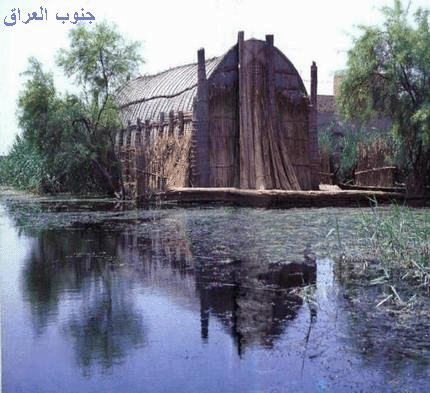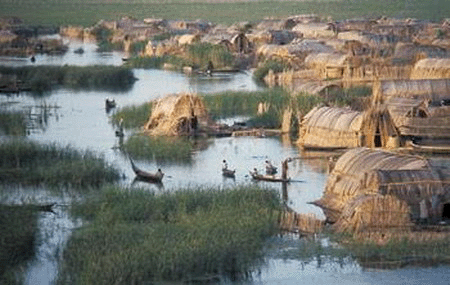It is believed that Marshes in southern Iraq were extensive and existed since times immemorial, as it is situated in a sedimentary plain exposed to immersion in water when the two great rivers overflow. The areas which were once known as the land of water by the Chaldean were inhabited since the Babylonian era and perhaps since the Sumerian era. However, old mounds rising above water and reeds here and there are not yet explored. Locals call these mounds "Eishan", and believe they are haunted with Jinn. However, this sort of belief provides some protection against illegal excavations, although that, some names like "Abu Thahab", as one of them was nicknamed so, point to potential presence of buried treasures there. Wealthy people of Marshes traded in, during the Babylonian epoch –certainly as in the case of their descendents today- grains, fish, hay, reeds, and Bawari (plural of Baria, mat weaved from reed), and other products. However, drying up and salting of fish was a basic industry always, and probably rice cultivation on large tracts was entered in later times.
In the cultivated areas like those on the banks of Kahlaa and Majar, and other small rivers and waterways, one finds himself on the outskirts of the Marsh. And though villages there are built of reeds and streets are waterways, the majority of these villages are connected with the mainland that can be accessed by car. Old railway between Basra and Amarah is used as a highway because it was built at a level higher than the areas surrounding it, and there is a good driveway between al-Halfaya and Amarah.
The more deeply one goes into the Marshes, waterways become the only possible way for transport. This network comprises here and there a real maze, many tales are reported about strangers who went astray for days in this maze, for reed is high and strong, so sight is almost obscured and the rows of dense reeds scrub against the sides of the graceful Marsh boats, with high prows and sterns and propelled by Mardi (long stick of thick reed).
However, sometimes wide surfaces of water open up, where winds make waves like those of the sea. Sudden winds usually sink the cruiser belonging to one of the Marsh elders, it was overloaded and water began to leak into it, river was flooding, reddish in color from mud, the shelf on both sides flat, thus both banks are identified here and there with willow already dense in leaves.
And if we were to walk faster and descend in a yellow river, we would find villages of reeds on both sides, and as the crew reduced the speed, the waves caused by the vessel scared the dwellers. For it splashed piles of fuel tablets (al-Matal) with water, and water bottles overturned (named al-Maskhana) and waves tampered with the Marsh boats (Mashaheef), and chickens flew apart into all the "Wateaa" coated with pitch – and caused their owners to scare, calves were quick to escape frightened to reed cottages "Sara'ef" (plural of Sarefa, reed cottage) in which they live with their breeders.
The deeper we go the scene seems closer to the real Marshes. Half-naked children running while shouting all along the banks, guard dogs barking with hoarse voice is becoming louder as we go deeper and deeper into the homeland of reed.
Houses of the Marshes' inhabitants are totally built of reeds without using nails or screws. Reed cottage is much like the tent, the cover is a mat placed over a skeleton made up of bundles carefully held together, and these bundles are named (Shebab, singular Sheba).
Bundles of strong reeds are tied up with ropes of papyrus. As for bigger cottages, like the sheiks guest houses, it is indeed a magnificent building; good guest house is sometimes the size of a chapel. However, bundles of reeds are planted in the ground in two rows, and then they are bent to meet in pairs at the top and fastened very carefully in such a way that it is impossible to see the point of contact between the two bundles. These sides are two feet (60cm) in thickness. On the other hand, many archeologists think that these are the precursor of Amarah arch.
Light enters the guest house from the door and in hot weather thru a grid from the sides. It is soft amber rays that infiltrate into the coolness and darkness of the sheiks' guest houses, grafted with the glittering bluish sun rays sometimes, and if happened and fell on a rich-colored carpet it undulate in the inner solemn part of the guest house, a lake image of emerald and sapphire.
Some affluent sheiks prefer to build guest houses of bricks, a deplorable change indeed. These are furnished usually with European furniture: chairs, tables of poor quality and taste. Whereas in reed guest houses visitors sit on ground mats and recline their backs to well-stuffed cushions.
On the other hand, hut of the poor is simpler; it is built on the same basis, mats over a structure but smaller in size and less tidy. And probably branches and wood are amassed on the sides of reed cottage for protection against north cold wind, and at the entrance a quantity of Alfa is left untied from the top, so wind brushes against its feathery points. Entrance faces the south usually and most often rows of fuel brown-color flat-surface tablets are found stuck to the outside walls of reed cottage for drying. These are made of buffalo dung mixed with chopped up reeds.
Moreover, reed villages are built of on the ground, and sometimes on the edge of water immediately, and when getting to the heart of the Marshes we find houses each of which stands on its own fabricated island.
In the dry season, when water level drops, a foundation of mud, reed and reed mats are placed in layers and all trampled carefully to create a large and robust platform able to carry the reed cottage and some livestock.
However, this platform level can be lifted by adding other materials, Alfa and sand fetched by boat. In some villages like Jabayesh (plural of Jabsha, the name of these fabricated islands), houses are distributed each on its respective small island. Streets are waterways, and the only way to visit your neighbor is by rowing nearby or over bundle of reeds, or by swimming. Children of the Marshes learn to swim at the time they learn to walk; most of them hold the paddle as if it was part of their limbs.
The furniture is made up of mud and reed like the reed cottage. Curtains are hung on a rail made of twisted Alfa; bed is of reed, while the crib woven from sheep wool is suspended with reed bundles. Rice and flour storage containers are made of mud, and likewise the grinder of grains, the looms on which women weave mats are made of mud and reed. There is always a mud pot with a lid – Aledda- where teapot and cups are kept. However, sheikh's wife has her dower box and a number of rugs, these rugs stack up sometimes from floor to ceiling. Each house erected on a small island has its own shaggy watch dog, a small flock of buffalo, some thin chickens, and a few pale cows; cows, by the way, are not happy at all in these villages consisting of many islands, because their movement is restricted in a tight space, and unless they go about into dry land they are fed on Alfa, the same also applies to seasonal sheep, yet buffalo find themselves in the heaven, for they wade and swim leisurely into their favorite grazing pastures in daylight, and come back at milking times or driven be a small boy riding one of them, as if they are of prehistoric creatures.
However, the people of Marshes depend on them in their food, from which they produce quality cream, yogurt, butter and cheese, and they make their bread of rice flour instead of wheat flour. Women make two types of bread, Seha (originally Sayyah), and Rassaa which is thinner. And to prepare salad they use watercress, and a plant with pink flowers called "Lakat", which was served to us sometimes flavored with vinegar and oil. There is also another type of edible Alfa named Ageyl, and from Papyrus pollen sweets are made (pollen is collected and cooked in steam to form a solid yellow clot with sweet taste known as Kherreit).
Understandably, Sheiks generosity cannot be rejected, lest their reputation would be defiled when they appear unable to provide the best they could to their guests. They are offered sweet tea, and cigarettes in the guest house, seemingly, arrangements and food preparations will not start until the guests are settled. While awaiting sheep and chicken are not slaughtered but at that time, whereupon sheep are skinned, chicken are plucked out and then cooked. Then rice, fish and sweets are prepared (usually pudding is made of ground rice cooked with milk and flavored with rose water), therefore, meal is prepared in three or four hours, however, often served cold. Waiting times are whiled away in talking, and the Arabs of Marshes are skilled talkers. Women in the Marshes enjoy dancing when they are alone, but they believe that dance is disgraceful before men. This is quite different from women in northern Iraq, where Kurdish woman dance Dabka with men in all celebrations.
Nevertheless, women keep going: they grind grain, cook and milk livestock, knit and dye clothes, feed livestock, bear many children and shoulder the burden, until they are incapable very early. Men, their husbands and wronged, with their children as well, seek advice and comfort from them, and so, many women have power over their husbands surreptitiously.


